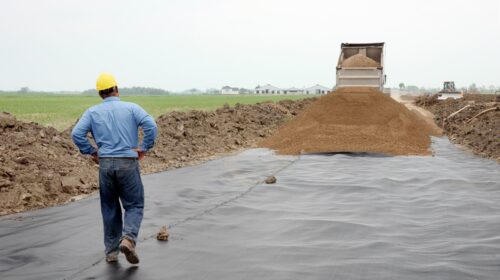The ongoing debate is whether geotextiles are environmental saviors or their biggest detriment. Some contend that these manufactured synthetic fabrics have too great an impact on the environment, while the other side of the conversation shows how geotextiles can improve water quality, erosion control, and greenhouse gas emissions.
Regardless of where you stand in the debate, geotextiles have become indispensable for their ability to solve many problems related to civil engineering projects.
What Are Geotextiles?
Geotextiles are manufactured synthetic or natural fabrics used in civil engineering, construction, and landscaping projects. Their primary role is to protect the durability of disturbed and undisturbed soil—reduce erosion and increase structural integrity. They function as filtration, drainage, reinforcement, and protection of soil resources.
Geotextiles are made from thermoplastic polymers, such as polypropylene (PP), polyethylene terephthalate (PET), and polyethylene (PE), glass fibers, and renewable and biodegradable materials. Geotextiles degrade over time as new vegetation reclaims the disturbed area or due to environmental factors such as UV radiation, wind, and water.
There are three common types of geotextiles designed for different uses:
Woven geotextiles
These are manufactured by weaving fibers together to create a strong, durable fabric. They’re used in areas requiring high-tensile strength and puncture resistance. The most common applications for woven geotextiles are road and rail underlayment and retainment wall reinforcement. Woven geotextiles are mostly impermeable and do not provide good drainage.
Non-woven geotextiles
These fabrics are manufactured by bonding synthetic fibers together. These felt-like fabrics are used in areas where drainage is necessary. Their main function is filtration, separation, and drainage. They are commonly used for erosion control.
Knitted geotextiles
These are made by interlacing loops of yarn together. Knitted geotextiles offer a balance of flexibility and strength. They are commonly used for soil stabilization where drainage and reinforcement are needed.
How Do Non-Sustainable Geotextiles Support Sustainability?
Fabrics manufactured from PET and other synthetic materials can break down under ultraviolet exposure, releasing microplastic pollution. Even so, non-sustainable geotextiles still support sustainability and have environmentally beneficial effects. Geotextiles are used to reduce erosion and preserve and safeguard natural resources, including our water supply. Geotextiles provide several key functions:
Separation
Geotextiles are used to separate different layers of soil or materials to prevent them from mixing and contamination. This is particularly important where structural integrity is required, such as road projects.
Filtration
Different fabrics allow water to percolate through but capture fine particles and sediment. Filtration prevents clogging and soil loss in drainage systems, embankments, and retaining structures.
Reinforcement
A critical application of geotextiles is to reinforce weak areas and improve strength and stability. Civil engineers often include geotextile use in retaining walls, embankments, and slopes.
Drainage
Geotextiles can channel water away from soil or other construction materials to prevent soil instability or water build-up on site. They are also used to keep contaminants from spreading.
Erosion control
Different geotextile fabrics control soil erosion by providing a protective layer over the soil. This application is particularly helpful where rain, water, or wind can wash or degrade the soil layers. Geotextiles are a common application adjacent to riverbanks, streams, and coastal areas.
Protection
Puncture-proof geotextiles are used to protect structures from damage caused by environmental factors. They act as a cushioning layer or waterproof membrane often used in infrastructure projects.
Finding a Suitable & Sustainable Alternative
Most geotextiles are made from permeable synthetic materials but there are alternatives available, including organic materials, biodegradable materials, and synthetic and natural blends. Natural fibers, such as jute, coir, palm fiber, nettle, straw, cotton, and wool are becoming more readily available. These naturally biodegradable fibers can replace synthetic materials in 50% of all applications.
While many geotextiles are used for long-term containment or projection, there is a need for fabrics with shorter life spans. Natural fibers with high cellulose content have a high mechanical strength, yet still biodegrade more quickly than their synthetic counterparts. These fabrics serve as the intermediary step between disturbed and re-established vegetation.
Eco-friendly geotextiles have demonstrated effectiveness in performance and sustainability. Natural fibers are successfully being used in erosion control and slope stabilization where revegetation is implemented. Although natural fibers pose some limitations regarding water uptake and stability, they have a viable function—biodegradable materials decompose over time to reduce long-term waste from microplastics and contribute to a healthier ecosystem.
As civil engineers, the choices you make regarding materials can have a profound impact on the outcome of the project and its environmental footprint. As the availability and use of sustainable geotextiles continues to grow, it is critical to understand how these fabrics can be integrated into the overall design to provide more eco-friendly solutions.
To learn more about geotextiles and implementing those into design while meeting your continuing education requirements, consider McKissock’s Geotextiles in Engineering course. The course provides an overview of the application of geotextiles and serves as a springboard to the vast use of geotextiles in civil engineering.






